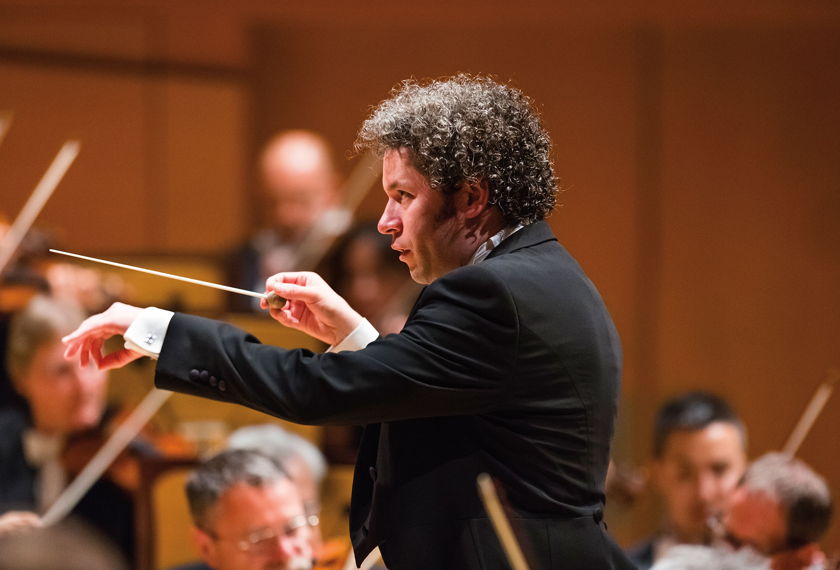
On Thursday and Saturday nights, Gustavo Dudamel and the LA Phil concluded their two-week series of programs featuring the four symphonies of Charles Ives and the last three symphonies of Antonín Dvořák with Ives’ The Unanswered Question, his Symphony No. 3 “The Camp Meeting,” and Dvořák’s Symphony No. 9 (“From the New World”) (on Thursday) and the same program on Saturday, but with Ives’ Symphony No. 4.
Dudamel began both concerts with Ives’ The Unanswered Question, composed in 1908 and revised in 1934. It is scored for strings, solo trumpet and woodwinds (4 flutes or 3 flutes and clarinet). Against a backdrop of quiet strings playing almost imperceptibly and representing, according to Ives, “the silence of the Druids, who know, see and hear nothing,” the solo trumpet repeatedly poses the five-note “perennial question of existence,” which is answered by the woodwinds, quietly at first and then more and more erratically. A typical performance has the three separate groups of instruments situated where they cannot see one another with the strings offstage. Dudamel, however, placed all the instruments offstage, and he conducted them standing all alone on the podium in the darkened auditorium facing a stage with empty chairs. It was as if he were conducting ghosts. The effect was dramatic and eerie.
On Thursday, Dudamel conducted the Ives Symphony No. 3 and on Saturday the Symphony No. 4. The third symphony is the bridge between the more tonal and late-Romantic European Symphonies Nos. 1 and 2 and the large atonal and often cacophonous Symphony No. 4. What both have in common, however, is their liberal use of American hymns and songs. In the fourth symphony, with the exception of the chorus in the first and fourth movements — performed exquisitely, as always, on Saturday night by the Los Angeles Master Chorale — the hymns and tunes are interwoven often within the polyrhythmic, atonal playing called for in the score.
The third symphony, “The Camp Meeting,” looks back to Ives’ childhood memories of camp meetings he attended where his father provided the music and conducted the congregational and choral singing of hymns. Thus, the movements are subtitled Old Folks Gatherin’ (Andante maestoso), Children’s Day (Allegro) and Communion (Largo). The score, the shortest of Ives’ three symphonies, calls for a small, chamber-size orchestra with only one flute, oboe, clarinet and bassoon, two horns, trombone, timpani, chimes (in the last movement and played offstage) and strings. Dudamel and the Phil provided a moving performance that left an impression of nostalgia.
The fourth symphony calls for an enormous orchestra with an assortment of percussion instruments, organ, a quarter-tone piano and strings that are often playing different parts within the same section. The score also calls for an offstage string ensemble and typically requires two conductors, one to conduct the onstage orchestra and one to conduct the off-stage players. On Saturday night, Dudamel led the orchestra while LA Phil Assistant Conductor Marta Gardolińska conducted the off-stage players. It was quite a spectacle with hundreds of players and singers and was a dramatic contrast with The Unanswered Question with its lone conductor on a player-less stage. With the genius of Ives and the brilliance of Dudamel and the LA Phil musicians, the audience was treated to a sonic extravaganza with music seemingly coming from everywhere.
Dudamel ended both concerts with an energetic and rousing performance of Dvořák’s Symphony No. 9. Freed from the scores of the Ives, which Dudamel uncharacteristically used, he was able to give a free-flowing performance of the Dvořák. He frequently modulated the tempos, especially in the first and fourth movements, to increase the already dramatic effect created by Dvořák. Dudamel took a symphony with more recognizable and singable melodies than just about any other symphony and breathed new life into it. As these concerts were all recorded, I would imagine that the Phil will use the performance on Saturday night, as the one on Thursday night had a subtle but noticeable flub in the horns in the last movement. But all the principal woodwind players, including Carolyn Hove on English horn, Andrew Bain on horn, Denis Bouriakov and Catherine Ransom Karloy on flute, Whitney Crockett on bassoon and Boris Allakhverdyan on clarinet were superb. And Dudamel was like a child having fun in the candy store of Dvořák’s ninth symphony.
—Henry Schlinger, Culture Spot LA
Visit www.laphil.com.





